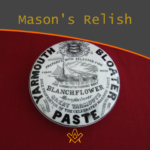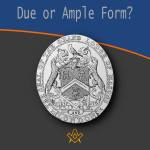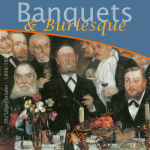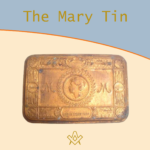A great story foretells the 1914 Christmas ‘Mary Tin’ (also known as the Princess Mary Christmas Gift Box) issued to the troops during World War One.
In good unpolished order, in fact hardly touched, it measures 5 by 3 ½ by 1 inch. But who was Mary, and what is the Masonic connection?

Christmas 1914 was a unique Christmas. When Britain had gone to war against the Central Powers the previous August, there was a great optimism that the war would soon be over and the troops would be home to enjoy their respective celebrations.
The festive period produced a relaxed atmosphere on many parts of the front, with reports of many cases of fraternisation with the enemy.
What in fact transpired in the long-term was a bitter stalemate, with troops entrenched opposite one another on a 475 mile-long front for a period of over four years, with none of the good will of that first Christmas.
In August 1914, Britain first sent over to France and Belgium the British Expeditionary Force (BEF), that ‘contemptible little army’.
The call for additional volunteers had been overwhelming, and the hearts of the British nation, and, indeed, the Empire, went out to those troops who were facing a Christmas away from their loved ones back home.
Various organisations and individual members of the public were generous in their supply of food, tobacco, warm clothing and other little ‘treats’ for the soldiers at the front and the sailors afloat.
The tin itself depicts the head of Princess Mary in the centre, surrounded by a laurel wreath and flanked on either side by the ‘M’ monogram.
At the top a decorative cartouche contains the words Imperium Britannicum with a sword and scabbard either side.
On the lower edge, another cartouche contains the words ‘Christmas 1914′, which is flanked by the bows of battleships forging through a heavy sea. In the corners, small roundels house the names of the Allies: Belgium, Japan, Montenegro and Servia; France and Russia are at the edges, each superimposed on three furled flags or standards.

Mary, Princess Royal and Countess of Harewood, from a 1926 postcard
IMAGE LINKED: wikimedia Attribution 4.0 International (CC BY 4.0)
In November 1914, an advertisement was placed in the national press inviting monetary contributions to a ‘Sailors & Soldiers Christmas Fund’ which had been created by Princess Mary, the seventeen year old daughter of King George V and Queen Mary.
The purpose was to provide everyone who would be wearing the King’s uniform on Christmas Day 1914 with a ‘gift from the nation’.
The Princess Mary, Princess Royal and Countess of Harewood, (Victoria Alexandra Alice Mary Lascelles, née Windsor) (25 April 1897 – 28 March 1965) was a member of the British Royal Family.
She was the sixth holder of the title of Princess Royal. Mary held the title of princess with the style Highness from birth as the then great-granddaughter of the British Sovereign, later Her Royal Highness, and then as the granddaughter and finally daughter of the Sovereign.
After her marriage she held the title of Countess of Harewood.
The response was truly overwhelming, and it was decided to spend the money on an embossed brass box, based on a design by Messrs Adshead and Ramsey.
The contents varied considerably; officers and men on active service afloat or at the front received a box containing a combination of pipe, lighter, 1 oz of tobacco and twenty cigarettes in distinctive yellow monogrammed wrappers.
Non-smokers and boys received a bullet pencil and a packet of sweets instead.
Indian troops often got sweets and spices, and nurses were treated to chocolate.
Many of these items were dispatched separately from the tins themselves to replace the standard issue of tobacco and cigarettes.
Orders for brass strip were placed with the USA, who were not yet involved in the war, and a large consignment was lost with the ship Lusitania.
As so much brass was being consumed in the production of weapons and munitions, the quality of the boxes which were manufactured later on was poor, being of a plated inferior alloy, or ‘pinchbeck’, when compared with the earlier pure brass examples.
It has been stated that the superior quality brass boxes were reserved for officers, although no evidence now exists to support this.
When the fund finally closed in 1920, almost £200,000 had been donated for the provision of more than two and a half million boxes with contents.
Mary married Viscount Lascelles in 1922 whose father was the current Queens private Secretary, a disciplinarian, and he, when he inherited the Earldom of Harewood on his father’s death, became the 6th Earl.
After her husband’s death in 1947, the Princess Royal lived at Harewood House with her elder son and his family.
She became the chancellor of Leeds University in 1951, and continued to carry out official duties at home and abroad.
She attended the coronation of Queen Elizabeth II in June 1953 and later represented the Queen at the independence celebrations of Trinidad and Tobago in 1962 and Zambia in 1964.
One of her last official engagements was to represent the Queen at the funeral of Queen Louise of Sweden (formerly Lady Louise Mountbatten) in early March 1965.
Later in 1965, the Princess Royal suffered a fatal heart attack during a walk with her elder son, Lord Harewood, and his children in the grounds of the Harewood House estate.
She was buried at Harewood after a private family funeral at York Minster.

Masonically, and of significant note, Viscount Lascelles, Lord Harewood, became Grand Master of the United Grand Lodge of England in 1943, although his tenure was cut short by his untimely death in 1947 (4 years) which led to six months of Masonic mourning and the adorning of ‘black’ rosettes on aprons.
Some text sourced from Wikipedia under the Creative Commons Attribution-ShareAlike 3.0 https://creativecommons.org/licenses/by-sa/3.0/
Article by: Paul Gardner

Paul was Initiated into the Vale of Beck Lodge No 6283 (UGLE) in the Province of West Kent, England serving virtually continuously in Office and occupying the WM Chair on three occasions.
Paul joined Stability Lodge No 217 in 1997 (UGLE) and now resides with Kent Lodge No 15, (UGLE) the oldest Atholl Lodge with continuous working since 1752, where he was Secretary and now Assistant Secretary and archivist, having been WM in 2002.
In Holy Royal Arch he is active in No 15 Chapter and Treasurer of No 1601, which was the first UGLE Universities Scheme Chapter in 2015.
He was Secretary of the Association of Atholl Lodges which maintains the heritage of the remaining 124 lodges holding ‘Antients’ Warrants and has written a book on Laurence Dermott. - https://antients.org

Christmas 1914: The First World War at Home and Abroad
By: John Hudson
By December, 1914, it had become clear to even the most optimistic observer that the war would not be over by Christmas.
That month brought the first enemy-inflicted deaths of the war, when German warships bombarded three northeast coastal towns; meanwhile, the recently invented airplane was being put to deadly use in raids over the southeast.
In France that month, the Battle of the Marne gave a taste of the devastating power of modern warfare—a reality to which troops in the trenches on both sides tried to turn a blind eye in the famous Christmas truce.
This book uses contemporary newspapers and magazines, diaries, and other records to present a comprehensive image of this extraordinary Christmas, both at home and abroad.
Recent Articles: by Paul Gardner
 Exchanged the Sceptre for the Trowel Explore the intriguing history of Royals and Freemasonry following the new Monarch's Coronation. From Prince Albert's initiation to the influence of George II and beyond, discover why royalty has long exchanged the sceptre for the trowel, shaping society and maintaining power through this ancient craft. |
 Unearth the mystic origins of Freemasonry in 'That He May Be Crafted.' Paul Gardner explores the symbolic use of working tools from the earliest days of this secret society, revealing a time when only two degrees existed. Delve into this fascinating study of historical rituals and their modern relevance. |
 Paul Gardner looks to a time when politics and Masonry were not precluded, but shush! This was London Masons and the Spitalfields Act of 1773-1865. |
 That rank is but the guinea’s stamp, the man himself’s the gold. But what does this mean, even given the lyric and tone of Burns’ time? It is oft times used in a derogatory sense, (somewhat in good humour) between Masons (or not) on the achieving of honours. But its antecedents are much more complex than that. |
 John and Timothy Coleman Blanchflower were initiated in Walpole Lodge, No. 1500, Norwich England on 2 December 1875; noted as a purveyor of ‘sauce’ to masons! |
 Jacob’s Ladder occupies a conspicuous place among the symbols of Freemasonry being on the First Degree Tracing Board, the most conspicuous and first seen by the candidate on his initiation – a vision of beauty and intrigue for the newly admitted. |
 During a detective hunt for the owner of a Masonic jewel, Paul Gardner discovered the extraordinary life of a true eccentric: Dr William Price, a Son of Wales, and a pioneer of cremation in Great Britain. Article by Paul Gardner |
 Paul Gardner tells the story of his transition from one rule book to another – from the Book of Constitutions to the Rule Book for Snooker! |
 Due or Ample Form? What is ‘Ample’ form, when in lodges the term ‘Due’ form is used? |
 The Butcher, the Baker, the Candlestick Maker Paul Gardner explores the Masonic link between provincial towns’ craftsmen, shop keepers and traders in times past. Many remain in the modern era and are still to be found on the high street. |
 Masonic dining and banquets, at least for the annual Investitures, were lavish, and Kent Lodge No. 15, the oldest Atholl lodge with continuous working from 1752, was no exception. |
 The ‘cable-tow’ or ‘noose’ is used in Craft Masonry as part of the ritual, as are ropes and ties in other degrees - but what does it symbolise? |
 Paul Gardner reflects on those days of yore and the “gentleman footballer” in Masonry |
 What is the Masonic connection with the 1914 Christmas Mary Tin |
 That Takes the Biscuit - The Patriot Garibaldi Giuseppe Garibaldi Italian general and politician Freemason and the Grand Master of the Grand Orient of Italy. |
 W.Bro. Paul Gardner looks at a mid 19th century artefact and ponders ‘Chairing’ |
masonic knowledge
to be a better citizen of the world
share the square with two brothers

click image to open email app on mobile device








